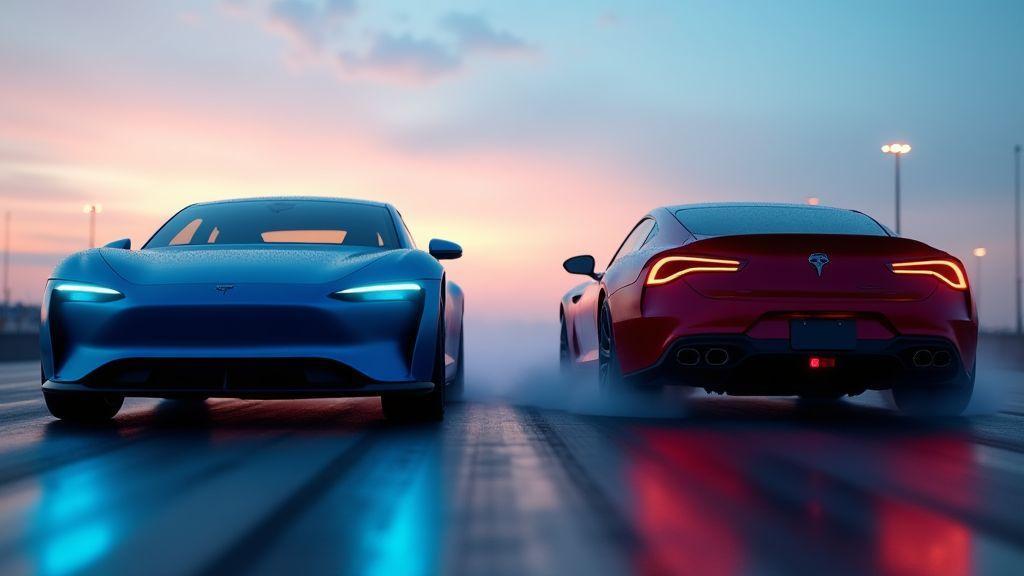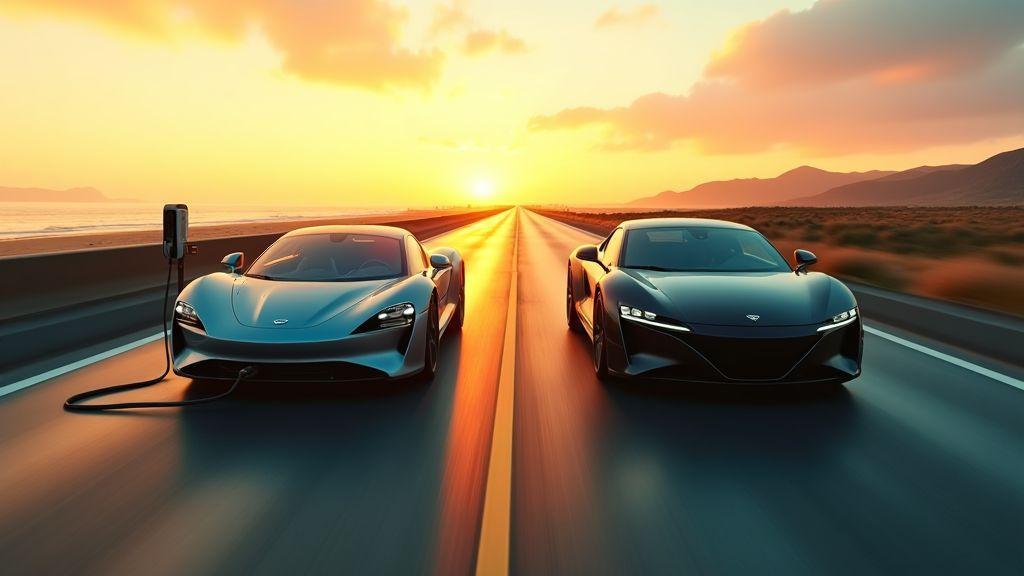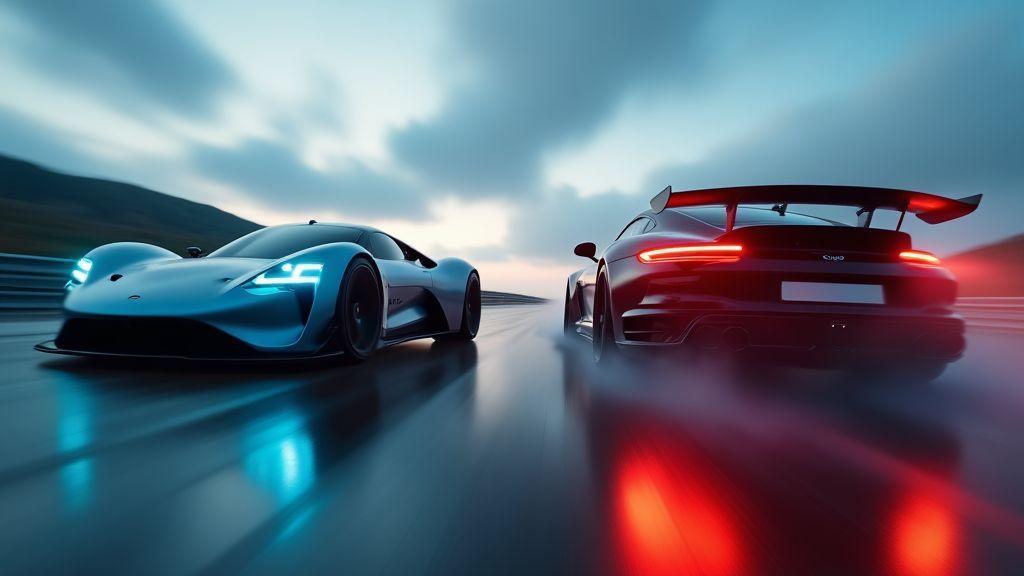Electric vs Gas Sports Cars: Performance Comparison
This short guide shows you how to judge acceleration and torque, and how to measure real-world sprint times for EVs and petrol cars. You’ll learn how instant torque changes launch feel, and how battery weight affects handling, balance, cornering and braking on track. You get clear notes on range, charging versus refueling, and the maintenance and running costs you should plan for. Finish ready to compare street and track performance like a pro.
Key Takeaway
- Electric sports cars deliver instant torque and very quick acceleration.
- You may face shorter driving range and longer recharge times compared to fast gas refueling.
- Handling benefits from a low center of gravity, but extra battery weight can reduce agility.
- Maintenance is often lower with electric drivetrains than with gas engines.
- Driving feel is quiet and smooth with EVs and louder and more tactile with gasoline cars.

Electric vs Gas Sports Cars: Performance Comparison for Acceleration and Torque
When comparing Electric vs Gas Sports Cars: Performance Comparison, acceleration and torque show the clearest differences. Electric cars deliver power instantly from a standstill — like a sprinter out of the blocks — (Electric motor torque and EV basics) while gas cars build power as engine rpm rises, with the push growing as you rev.
Judge performance by what matters to you: how fast you hit freeway speed, reaction at a light, and pull out of corners. Electric drivetrains give a sharp, immediate shove; gas engines reward revs, shifting feel, and sometimes higher top speeds. Numbers tell half the story; the seat-of-your-pants feel tells the rest.
Pick the right tool for your goals. If you crave launch thrills and quick in-town passing, electric models often have the edge. If you want long top-speed runs or engine sound and shifting engagement, gasoline sports cars still shine.
How you measure EV vs gasoline sports car acceleration
Measure acceleration with controlled, repeatable tests: same driver, same weather, flat surface. Refer to Standards for vehicle performance testing and published methods when you set up runs to ensure results are comparable.
Common metrics: 0–60 mph, 0–100 km/h, quarter-mile times, and intermediate sprints like 0–30 or 30–70 mph to show passing ability. Record tire grip, traction control, and launch settings.
- Set baseline conditions (fuel/battery level, tire pressure, driver).
- Run multiple timed launches and discard outliers.
- Record 0–60, 30–70, and quarter-mile times.
- Note traction control, launch control, and road surface for each run.
Instant torque advantage and electric sports car torque comparison
Electric motors produce peak torque at zero rpm, so you get full pull the moment you open the throttle — excellent for stoplight runs and quick overtakes. Gas engines reach peak torque higher in the rev range, requiring downshifts or revving for the strongest pull. Torque figures on paper can be similar across some EVs and gas cars, but delivery timing is the game changer.
0–60 times versus petrol sports car top speed comparison
EVs often dominate short sprints while gasoline sports cars can hold higher top speeds on some models. Typical ranges:
| Vehicle Type | Typical 0–60 mph (s) | Peak Torque (lb-ft) | Typical Top Speed (mph) |
|---|---|---|---|
| Electric sports cars | 1.9–4.0 | 300–1000 | 150–200 (often limited) |
| Gasoline sports cars | 2.5–4.5 | 250–600 | 180–220 (varies) |
Electric vs Gas Sports Cars: Performance Comparison for Handling and Track Dynamics
You feel the difference when you push the throttle. EVs’ instant torque and flat power band give strong corner exits without waiting for revs; petrol cars rely on rev range and gear changes, offering predictable delivery and engine braking. On track, EVs can blast out of turns quicker, while petrol cars let you control power through shifts.
Weight and balance shape the rest of the story. Batteries add kilos but sit low and central, lowering the center of gravity and making an EV feel planted. Petrol cars are lighter and can be tuned for nimble direction changes. On twisty courses you’ll notice an EV’s mid-corner inertia versus a petrol car’s quicker turn-in. For deeper technical context on mass effects and thermal limits, see Vehicle dynamics, mass, and handling research.
Thermal limits matter for lap times. Electric motors retain torque well, but batteries heat up on sustained hard runs and software may dial back power. Petrol engines also heat and wear, but refueling and cooling cycles are familiar. When comparing Electric vs Gas Sports Cars: Performance Comparison, weigh raw lap attack against how many laps maintain peak pace.
How battery weight impacts sports car performance and balance
Battery weight is the trade-off: lower center of gravity and reduced body lift versus increased inertia. That mass improves stability in fast sweepers but raises the effort to change direction in technical sections. Tuning (springs, dampers, anti-roll bars, chassis stiffening) and systems like torque vectoring can mask heaviness, but at the limit you’ll notice larger mid-corner weight transfer and slower transitions than a light petrol car.
Electric vs petrol sports car handling on corners and braking
Petrol cars often reward finesse on entry and mid-corner through engine braking and lighter rotating mass, giving tactile feedback to judge limits. EVs shift the balance: regenerative braking provides strong initial retardation and recovers energy but can alter pedal feel. Modern EVs blend regen and friction brakes for consistent feedback, and torque vectoring helps on exit.
Range and track performance — electric sports cars
Track use drains batteries quickly. Heat builds in packs and cooling can be overwhelmed, so power may be reduced or you’ll need cooldown periods. Lap times can fall after a few hot laps unless the car has aggressive thermal management. Stint planning and charging strategy become part of racecraft.
- Cool between sessions and plan short stints to keep power up.
| Attribute | Electric | Petrol |
|---|---|---|
| Peak torque delivery | Instant, full at low rpm | Builds with revs, needs gears |
| Center of gravity | Low due to battery pack | Depends on engine placement |
| Mass effect on agility | Heavier, more inertia | Lighter, quicker direction changes |
| Braking feel | Regen friction; can vary | Consistent friction feel, engine braking |
| Thermal limits | Battery heating reduces power | Engine heat; can be refueled and cooled |

Electric vs Gas Sports Cars: Performance Comparison for Range, Charging, and Costs
This comparison is more than a headline — it’s a decision you live with every mile. Electric sports cars deliver instant torque and blistering off-the-line speed that surprises at a stoplight. Gas cars still win on raw range for many models and on fast refuels; you can be back on the road in minutes. Choose sprint performance or long-distance freedom based on how you use the car.
Range behaves differently. EV range drops faster if you push acceleration, run HVAC, or cruise at high speed. Gas consumption also changes with style, but fuel gauges feel steadier. You’ll notice an EV’s range estimate change in real time; that changes trip planning. For official guidance on real-world range and emissions factors, consult EV range, charging, and emissions guidance.
Costs split into upfront and ongoing buckets. EVs can be pricier to buy, but electricity per mile often costs less than gasoline. Resale values, incentives, and charging access affect lifetime cost. For sports cars, factor tire, brake, and track costs — both types wear components differently.
Charging time vs refueling time comparison you need to plan
Charging an EV is a planned stop. Home Level 2 charging fills overnight; public DC fast chargers add big chunks in 20–40 minutes but availability varies. You don’t usually top off quickly like at a pump; instead, schedule longer stops or combine charging with breaks.
Refueling a gasoline sports car is quick and predictable: a 5–10 minute stop gets you back on the road. That’s handy for long drives or back-to-back track days when downtime matters.
| Charge/Refuel method | Typical time | Practical note |
|---|---|---|
| Home Level 2 (EV) | 4–12 hours | Best for daily use; plug overnight |
| DC Fast Charge (EV) | 20–40 min (10–80%) | Great for road trips if chargers available |
| Gas pump | 5–10 min | Fast, widely available |
Maintenance and running costs — electric vs gas sports cars for owners
EVs eliminate oil changes, spark plugs, and many transmission repairs. You’ll still pay for tires, suspension, brakes, and battery service. Regen braking often reduces brake wear. Battery replacement is a headline cost but warranties and falling battery prices ease that concern; review the site’s terms of use for ownership and warranty details that may affect long-term value. For consumer-facing ownership cost comparisons, see Comparing EV and gasoline ownership costs.
Gas sports cars need regular oil, filters, belts, and emissions checks. High-performance engines require premium fuel and more frequent servicing when driven hard. Track time accelerates wear on both types.
Practical cost items to watch:
- Annual service items: fluids, filters, brakes (compare intervals and labor costs).
- Fuel/electricity per mile: calculate typical miles and local prices for a realistic yearly estimate.
- Wear from spirited driving: tires and drivetrain parts wear faster; factor in track or canyon runs.
How you manage range and pit stops on long drives or track days
On long drives, plan charging stops at meals or scenic breaks and choose routes with reliable fast chargers for EVs. For gas cars, aim for quick fill-ups and consider a spare jerry can for remote travel. At the track, rotate cars into the pits between sessions, cool brakes, top fluids, check tire temps — and for EVs, monitor battery temps and precondition before a hot session. If you need specific advice or help planning a route or event, reach out via the site’s contact page.
Conclusion
You’ve seen the trade-offs: instant torque and explosive launches versus longer range and quick refuels. If you chase stoplight thrills and sharp exits, an electric sports car’s launch feel and torque delivery will grab you. If you prize sustained high-speed runs, tactile engagement, and quick turnaround on long trips, a gasoline sports car still answers the call.
On track, decisions hinge on battery weight, thermal limits, and stint management. Test like a pro: consistent conditions, repeat runs, and logged 0–60 / 30–70 / quarter-mile times reveal the truth. Expect EVs to hold power short-term and deliver repeatable torque until heat steps in; expect petrol cars to reward revs, shifting skill, and nimble direction changes.
Balance upfront price, running costs, and maintenance against how you actually drive—daily commute, canyon blasts, or full track days. The numbers guide you, but the seat-of-your-pants feel seals the deal. Make your pick based on what you value most: sprint supremacy, long-haul freedom, or a blend of both. For more deep dives and practical guides, visit the Meridian Pioneer home page. Before sharing account details for charging or event signups, check the site’s privacy policy.

